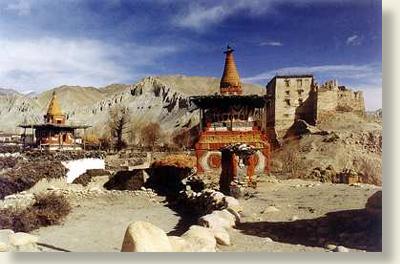
Overview:
Rarely do you find a place with invaluable medieval heritages and equally striking work of the nature existing together as a combined masterpiece, as you do here in Upper Mustang. The 21st century appearance of the ancient kingdom seating on the elevated Tibetan Plateau of the republic of Nepal is more or less still the same as it was centuries ago. The inhabitants of this pre-modern territory have changed their lifestyle to a modest degree and you will notice a few foreigners ambling here and there. However, the structure of houses is still the same; the richness of the festivals hasn’t abated; and the gompas still preserve their old ritual, relics and arts. While politically a district of modern Nepal, the political upheavals in the country affected this region almost insignificantly, probably due to the geographical barrier. Ironically, there is an opinion regarding this almost intact preservation of the long-standing Tibeto-Buddhist culture: the annexation of Mustang into Nepal safeguarded the kingdom’s culture and heritage against the most-likely invasion by the ‘super-power’ neighbor during late 1950s.
Only a little was known of this forbidden kingdom until 1992 after which a controlled access was granted to the foreigners, though, an Italian Tibetologist had made a visit to the secluded region in 1952! The kingdom was founded by a king named Ame pal whose lineage was followed until 2008 when the last king here was stripped of his power due to sudden political transformation in Nepal. Nonetheless, his prominence and esteem on behalf of the residents haven’t dwindled.
The capital of Upper Mustang and the central point of the whole trek is – Lo Manthang, bordered medieval town of the Kingdom of Mustang. The artistic monuments rich in texture and arts, internally as well as externally credit their exquisiteness to the affluence of the kingdom that hired Newar craftsmen and architects from the Kathmandu valley. The place attracted attention of serious tourists after the discovery of 55 caves consisting of medieval paintings depicting the life of Buddha with Indian influence. Apart from Lomanthang, the places lying between here and the start point of the trek- Kagbeni have their own significance, from spectacular landscape to the preserved Tibetan heritage. This remarkable maintenance logically justifies the steep entrance permit to the reason.
Major highlights of this trek are:
Total duration of the trek: 17 days. Click here for a comprehensive itinerary.
Do you have any questions or concerns about this package? If yes then respond by filling up the form below and get in touch with the people at VisitNepal.com. Make sure you include your name, phone number and e-mail address so that we can get back to you soon.